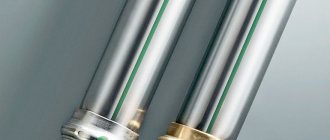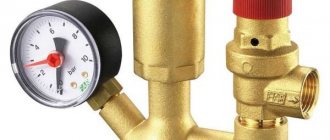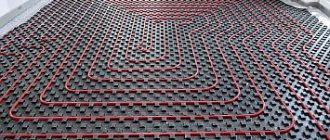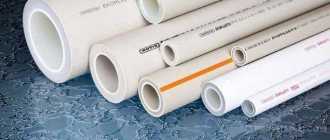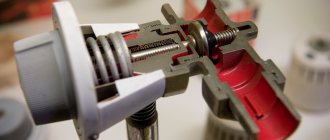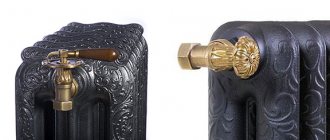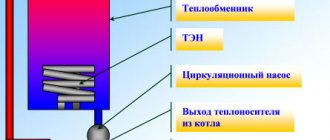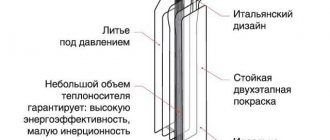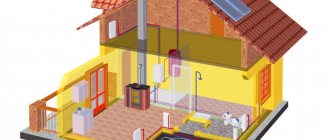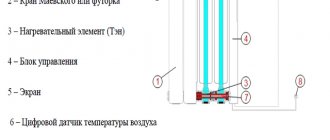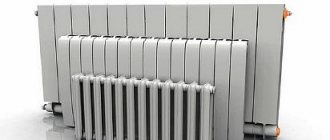For water heating, you can use different types of pipes: steel, polypropylene, metal-plastic, cross-linked polyethylene, copper, corrugated stainless steel. They all differ in their characteristics and properties. Metal-plastic pipes are perfect for a water-heated floor system.
In this article we will analyze in detail the main pipe materials, after which you can make your own choice - which is best for your heating.
Pipes made of cross-linked polyethylene (PEX) are best suited for heating, followed by steel products. The characteristics of these materials have the necessary set of properties, thanks to which they can withstand high temperatures and pressure.
Installing a heating system is the most important task when building a country house or renovating a city apartment. The comfort of living depends on its effectiveness, especially considering the climatic conditions of our country. A number of questions arise here, one of which is which pipes are best to use for heating an apartment or house.
In the process of life, mankind has come up with many ways to distribute thermal energy evenly throughout residential and industrial premises. One of them is to use heating system pipelines that deliver coolant from the boiler to the radiators.
For this purpose, various materials are used, the quantity and quality of which is constantly growing. Let's take a closer look at which pipes are ideal for heating a house or apartment.
No. 1. What should heating pipes be like?
The purpose of heating pipes is clear even to a child. They must transport hot water from the boiler, whatever it is, to the radiators. This is a very important part of the heating system, on the quality of which not only our comfort, but also safety depends.
The following minimum set of requirements is put forward for heating pipes:
- strength and durability. Throughout their service life, the pipes must maintain their integrity. If minor damage occurs and oxygen penetrates through it, the pipes may begin to rust from the inside and become clogged. Large damage will lead to coolant leaks, and this, in most cases, is hot water. The consequences of all this can be catastrophic;
- low noise level during operation , because constantly listening to the sounds of bubbling water is a test for the nervous system;
- aesthetics. It is not always possible to hide pipes in the walls or disguise them, so they should not be frightening with their appearance, much less spoil the interior.
No. 2. What to consider when choosing heating pipes?
There are no universal pipes that would function equally well in different rooms. To select the best heating pipes , i.e. the most optimal and suitable in specific conditions, it is necessary to take into account the following factors:
- temperature and pressure in the system , which largely depend on what kind of heating is used, individual or centralized. In individual systems, the pressure rarely exceeds 2-3 atmospheres, and in centralized systems it can rise to 16 atmospheres;
- type of pipe laying , external or hidden;
- total area of heated housing;
- design boiler power and fuel type (for private houses);
- operating conditions of the pipeline. This refers to the presence of unheated premises in certain areas;
- possibility of repairs.
All characteristics of pipes depend on the material they are made of - this is the most important parameter that must be taken into account when choosing.
No. 3. Heating pipe material: main types
The following types of heating pipes are used in residential premises:
- steel;
- stainless steel;
- copper;
- polyethylene;
- polypropylene;
- metal-plastic.
Some of them (steel) are already becoming obsolete, others (polypropylene) are just conquering the market, but all of the listed types of pipes are produced and used today, because heating systems are very different and require an individual approach when installing.
Stainless steel
This material can be called a competitor to copper. Pipes go on sale in several versions:
- welded;
- seamless.
Of course, the second option is much better. This option completely eliminates the possibility of accidental damage. The cost of this product is much higher, but at the same time the service life increases.
The parameters of stainless steel pipes are the same as those of copper products. Thin-walled steel ones can be a good replacement for copper pipelines.
No. 4. Steel pipes for heating
Until some time, steel pipes were the most popular and practically the only option for organizing a heating system. Time has passed, worthy alternatives have appeared, but steel pipes are still installed, although mainly in private homes. They are made from high quality carbon steel.
Main advantages:
- strength, reliability, high resistance to water hammer, pressure and temperature surges in the system. The material is not afraid of mechanical damage;
- low coefficient of thermal expansion, so you can do without compensators;
- high thermal conductivity;
- Affordable cost is still one of the main reasons for choosing this type of pipe.
Minuses:
- low corrosion resistance. Gradually, the pipes begin to become overgrown, and their capacity drops. Moreover, corrosion processes can lead to leaks and pipe failure. To avoid this, it is recommended to protect the pipe surface by galvanizing;
- large weight and dimensions;
- complex installation. The individual elements are connected into a system by welding. If you do not have the skills to work with a welding machine , then you will need the help of professionals to perform installation work. Welding also means a high probability of damage to nearby objects and surfaces. An alternative option is a threaded connection with separate elements, but thread cutting is no less painstaking and time-consuming. In addition, you will have to deal with numerous couplings, angles and tees, the quality of installation of which determines the main thing - the integrity of the entire system;
- the material conducts stray currents that damage the inner surface of the pipes.
No. 5. Stainless steel pipes for heating
Corrugated pipes made of alloy stainless steel do not have many of the disadvantages of their steel counterpart. They are used to install heating systems in new houses, as well as to reconstruct the heating system in old ones; they have gained great popularity in the installation of heated floors, hot and cold water supply. Such a wide scope of application is explained by the main feature of this type of pipe – the ability to bend.
Advantages:
- Stainless steel corrugated pipes are resistant to corrosion, do not collect scale on the walls, and are durable;
- resistance to water hammer and external mechanical influences;
- slight thermal expansion;
- flexibility, and such a pipe bends practically without reducing the internal diameter. This is convenient when space for installing a heating system is limited. In addition, complex systems can be installed with a minimum number of connections. This feature has made stainless pipes very popular when installing water-heated floors;
- high heat transfer;
- relatively simple installation;
- wide scope of use.
As you might guess, there is only one disadvantage - the cost, but it pays off in durability and ease of installation . Another unpleasant feature is the low durability of the sealing rings, about 30 years.
Metal-plastic
The list is not limited to the listed types of pipes made of plastic materials. Polyvinyl chloride (PVC) can also be used for their production.
All these materials are fully endowed with one unpleasant feature - the ability to transfer oxygen from the air through existing microdamages into the cavity of the pipes. And oxygen is the strongest oxidizing agent (oxidation - from the word “oxygen”).
As a result, corrosion of metal parts of the heating system occurs. Without solving this problem, it is impossible to use such heating systems.
Various methods of reinforcing walls are aimed at strengthening them. And to solve the problem of coolant oxidation, aluminum reinforcement can be used. This material, when exposed to oxygen, creates a thin oxide film on the surface, which is resistant to most aggressive environments, excluding only mercury salts, which are extremely rare in nature.
The aluminum tape is wound in a spiral during the production process, and the edges are laser welded in a flow. An outer layer of plastic is applied over the metal jacket. In this way, a multilayer product with oxygen protection is formed.
When choosing metal-plastic pipes for heating, you need to take into account that any of their types can be used, but you need to pay attention to the characteristics of the material and the complexity of installation. Well, when choosing, an important criterion is their cost and presence on the market at the moment.
No. 6. Copper pipes for heating
Let's continue our study of metal heating pipes. Copper pipes began to be used back in the 17th century and are still actively used today, despite the emergence of cheaper options.
Advantages:
- durability, compared with the service life of buildings. Copper pipes and fittings do not lose their quality for 100 years or more;
- resistance to corrosion, high tightness, lack of ability to allow air to pass through and accumulate deposits on the inner surface, so the throughput of pipes does not decrease over the years;
- high thermal conductivity;
- resistance to temperature changes (operating temperature range from -200 to +5000C) and pressure surges in the system;
- aesthetic appearance.
The main disadvantage is the high price . Not only is the material itself expensive, but also the main manufacturers are concentrated outside the country. If we take into account the durability of the material and the absence of problems in the next 100 years, then the cost does not look like such a significant drawback. If the issue of choosing heating pipes does not depend on the budget, then copper pipes will be the best option. The installation process is specific, so it is better to seek help from professionals.
In order for the heating system to last for many years, it is better not to combine copper pipes with unalloyed steel . The latter will rust very quickly. If such a combination cannot be avoided, then let the steel pipes be in front of the copper pipes in the direction of water movement.
No. 7. Polypropylene pipes for heating
Polypropylene pipes are made from polymers; there are several types of such pipes, but PPs pipes made from special propylene are usually used in heating systems. Materials from the thermoplastic group, which include all types of polypropylene pipes, are unstable to high temperatures, so for heating systems it is necessary to use only reinforced pipes, preferably with aluminum foil .
Polypropylene pipes can be without reinforcement, reinforced with fiberglass or aluminum foil . We will not consider the first ones at all. The latter are of great interest. Pipes with fiberglass reinforcement are easy and quick to install, which is why heating system installers love them very much, but they either don’t know or deliberately keep silent about the fact that they cannot be used in high-temperature radiator heating systems. The reason is their oxygen permeability.
Oxygen is the enemy of the heating system . It can enter it along with the coolant, therefore, before entering the heating network, the water is prepared in a special way, reducing the amount of dissolved oxygen in it by several times. Another route of entry is from the external environment. Yes, oxygen can penetrate pipes and radiators from the air and enter the coolant.
Comparative indicators of thermal elongation and oxygen permeability
Why is oxygen dangerous? It destroys the metal elements of the heating system, i.e. in this case, it is not the pipes themselves that will suffer from corrosion , but valves, pumps, etc. In addition, you have to deal with cavitation processes . The air bubbles collapse, releasing energy that is sufficient to gradually damage the metal elements. Again, pumps, valves, etc. suffer. Research shows that due to the high oxygen permeability of pipes, heating system elements can fail within 3-5 years.
Cavitation. Destruction of the valve as a result of saturation of the coolant with oxygen
Low-temperature systems (warm floors, panel heating) equipped with polypropylene pipes without an oxygen barrier also suffer, but the main problem here is silting due to the development of aerobic microorganisms.
For heating systems, it is necessary to take pipes with an oxygen-impermeable barrier (diffuse layer) , while fiberglass allows oxygen to pass through. that remains is aluminum foil. It is important that it is without perforation and laser welded end-to-end. Foil with holes or overlapping will not protect the system from oxygen entering it.
Advantages:
- relatively long service life. According to the manufacturers, durability reaches 50 years;
- corrosion resistance. The inner surface of the pipes remains smooth throughout the entire service life, without compromising the throughput. Due to the tightness, oxygen does not pass into the system and does not damage its metal elements (in the case of aluminum reinforcement);
- high mechanical strength;
- light weight;
- resistance to low temperatures. If water is frozen in a pipe, you don’t have to worry about its integrity - thanks to its ability to expand, the material will not be damaged and will return to its original shape after thawing;
- hermetic connection, which is ensured by special fittings and welding;
- relatively simple installation process. To connect individual elements with fittings, a special welding machine is used, which is popularly often called an iron and a soldering iron. It takes a few seconds to weld a joint, and learning how to operate the machine is not difficult;
- low noise level when water moves through pipes, especially when compared with metal analogues;
- completely harmless to health;
- relatively low price. Polypropylene pipes will cost less than metal-plastic or stainless steel ones.
Among the disadvantages:
- inability to use in fire hazardous areas;
- high linear expansion results in the need to use compensators.
Disadvantages often include low heat resistance, low rigidity and instability to water hammer. This is due to the incorrect choice of polypropylene pipes. Heating systems require only reinforced products that do not sag and can withstand high temperatures and pressure. In addition, the production process is of great importance: if the technology is violated, pipes of inadequate quality come out, so it is better to give preference to proven, reputable manufacturers.
Water supply system components
The most famous sources for obtaining water are wells and boreholes.
Well. It is distinguished by the simplicity of the device (you can dig it yourself) and relative cheapness.
A well is best suited for supplying water to a small house or a summer cottage. When digging a well, you should remember that a high groundwater level can lead to contamination of the water in it, and the funds spent on its further purification will significantly exceed the initial costs of constructing the well.
Wells are divided into three types:
- Artesian. Depth of 100 meters or more.
They are considered the most expensive, since their construction requires drilling operations using special equipment. Due to their depth, they do not require pumping equipment inside the well, ensuring the rise of clean water under pressure. Often, special permission must be obtained to drill such wells.
- Wells up to 50 meters deep.
To raise water, it is necessary to use a submersible pump installed inside the well. And water from such wells, unlike artesian ones, requires the mandatory installation of filtration systems.
- Abyssinian or as they are also called driven wells. No more than 15 meters deep.
They are well suited for installation in hard-to-reach places, for example, such a well can be made even in the technical room of an already built house, but due to the small diameter of the pipe, it is impossible to install a submersible pump in such a well and a pumping station must be used to lift water.
After a choice has been made in favor of one or another source of water, it is necessary:
- Choose a water lifting system - a submersible pump or a pumping station.
It should be remembered that the pumping station ensures the rise of water from a depth of up to 10 meters. In addition, unlike a submersible pump, such a station is quite noisy, which requires additional soundproofing of the technical room. Or place the pumping station in a separate extension.
- Determine the power of the well pump. To do this, it is necessary to calculate the well flow rate.
Flow is one of the main characteristics of any well. Using the flow rate of a well, you can calculate the maximum amount of water it produces per unit of time. Flow is usually measured in liters or cubic meters per minute.
- Calculate the volume of water consumption in the house and select the necessary pump parameters.
Civil engineer Oleg Dunaev :
– If the house is residential, and people stay there around the clock, then the water supply must be calculated based on the total number of residents and all points of consumption.
After that:
- We select a hydraulic accumulator.
A hydraulic accumulator is necessary to maintain constant water pressure in the water supply system, which is usually from 2.5 to 3 atmospheres. The hydraulic accumulator also reduces the number of starts of pumping equipment.
- We decide on a water treatment system consisting of coarse and fine water purification filters.
Oleg Dunaev:
– Based on the results of water analysis, a method for its purification is selected. For example, rust removal in a simpler version can be done by filtration through iron-removing replaceable filter cartridges, or, with a more expensive method, a full-fledged water treatment station and water softening system are installed.
Then, based on all the above data, it is necessary to select pipeline fittings - consisting of pipes, fittings and manifolds.
No. 8. PEX pipes or cross-linked polyethylene pipes
Due to a special production technology, new molecular bonds appear in the structure of polyethylene, which provide additional strength and other useful properties. Today, such pipes are used not only in heating systems, but also in the installation of heated floors, as well as in the arrangement of hot water supply systems.
Advantages:
- corrosion resistance;
- strength along with sufficient flexibility;
- durability up to 50 years;
- ability to withstand coolant temperatures up to 1200C, temperature and pressure changes;
- light weight.
Among the disadvantages , we highlight the high price of the pipes and fittings themselves and the need for special equipment for installation, so they are used quite rarely.
Cross-linked polyethylene allows oxygen to pass through . Unreinforced pipes can be used in cold and hot water supply systems, low-temperature heating systems. In high-temperature systems, aluminum-reinforced pipes must be used.
No. 9. Metal-plastic pipes for heating
Many people call metal-plastic pipes the most balanced in terms of price/quality ratio. Such popular love has serious grounds. The product is made on the basis of polyethylene and aluminum foil: the outer and inner layers are plastic, in the middle there is foil, which plays the role of a frame and gives rigidity to the structure, and binds all layers with glue with high adhesion to metal and plastic. This structure allows us to talk about a lot of advantages :
- resistance to corrosion, because the coolant is in contact only with plastic;
- the inner layer is smooth and does not accumulate deposits;
- tightness and oxygen impermeability, so the metal parts of the system will be safe;
- the material bends well, so you can easily create an effective heating system even in rooms of complex configuration. Moreover, they sell pipes in coils of 50-500 m, so with one piece you can build a heating system in large spaces, and the fewer connection points, the less likely it is to leak;
- durability up to 50 years;
- relatively simple installation;
- the material does not transmit stray current.
Minuses:
- instability to mechanical loads and open fire;
- low resistance to ultraviolet rays, so it is better to use protection in the form of a corrugated pipe;
- the price is twice as high as for polypropylene pipes.
It is also worth noting such a property as the absence of linear expansion . On the one hand, you can safely embed pipes into the walls without fear of damaging the future finish. On the other hand, if the coolant freezes, the material will not withstand the load and will tear. This is a good option for permanently heated visits.
The elements can be connected using a detachable, conditionally detachable or one-piece fitting. The latter requires special, expensive equipment, and when installing a threaded fitting, great care is required, since the nut can damage the pipe.
Comparative Price Review
In construction and plumbing stores you can buy heating pipes, which are made from different materials:
- Copper. The average price for 1 meter (diameter 20 mm) is 250 rubles. Permissible temperatures of the working fluid are up to 500 degrees Celsius. They transmit stray currents, which is a disadvantage.
- Polypropylene. The average price for 1 meter is 50 rubles. Suitable for working with liquids with temperatures up to 95 degrees. Do not oxidize. Cannot withstand strong water hammer.
- Metal-plastic. The average price for 1 meter is 40 rubles. Temperature maximum - up to 150 degrees. The active service life is 15 years.
Prices vary depending on the diameter, wall thickness, and reputation of the manufacturer.
Copper pipes for heating
No. 10. So which heating pipes are best to choose?
If you plan to install the entire heating system yourself, then it is better to take polypropylene pipes . They are cheap, all connections are completely sealed, and even those with minimal construction experience can quickly learn how to use a special welding machine for polypropylene. More time will be spent not on installation, but on calculations and preparatory work. The main thing is to purchase aluminum foil-reinforced polypropylene pipes and stainless steel taps, and the entire system will work long and reliably.
Metal-plastic pipes are also a good option. Although they are more expensive, installation does not require any specific tools - only a wrench, but the connection risks losing its tightness over time.
If you have the means, stainless steel pipes are a good option . Copper pipes will cost even more, but they are worth it.
Subtleties of pipeline installation
To install a pipeline made of steel pipes, you need a welding machine (for electric arc or gas welding), a grinder, and a set of wrenches. In this case, even for the installation of detachable coupling connections with a threaded connection, welding work is necessary. The complexity of installation using rolled steel products is compounded by the need for a qualified welder and mechanic.
A pipeline made of polymer materials is installed using compression and crimp fittings (for detachable joints) or using diffusion soldering.
Fittings made of copper are also assembled using crimp and compression fittings, as well as capillary fittings. The installation of such systems can be carried out by one mechanic, who will need jointing, a soldering iron and sliding keys to work. In addition to tools, you also need flux, solder and fittings.
Heat pipes made of polymers are assembled using crimp and compression fittings (for detachable joints) and by diffusion soldering. Installation can be performed by one person even without experience. To connect, you just need to install the fitting at the end, heat the joints with a special unit and press them tightly.
